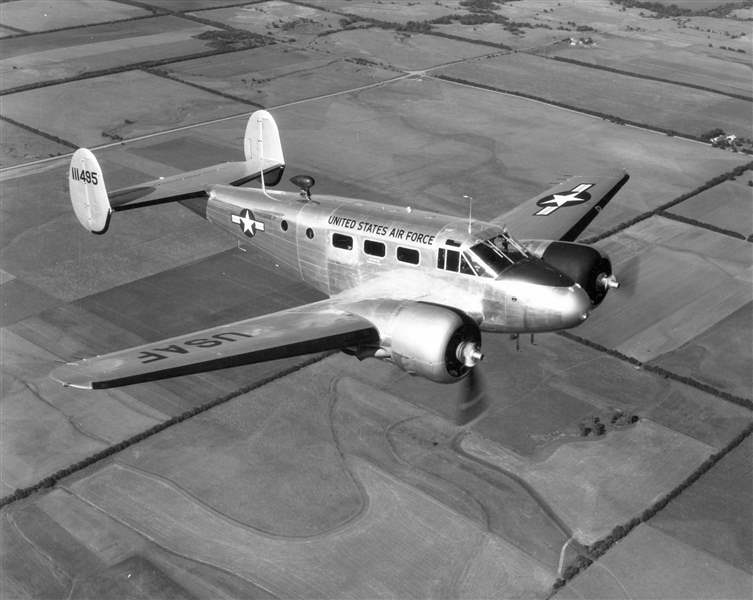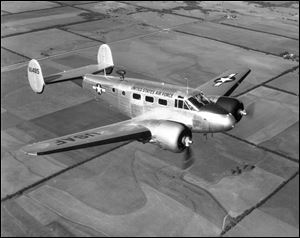
Explorers find 1952 U.S. plane wreck in Lake Ontario
Work funded in part by Great Lakes Historical Society, museum
7/8/2014
A U.S. Air Force C-45 aircraft was abandoned during flight by its crew in 1952 has been located in deep water off Oswego, New York.
shipwreckworld.com

A U.S. Air Force C-45 aircraft was abandoned during flight by its crew in 1952 has been located in deep water off Oswego, New York.
OSWEGO, N.Y. — The wreck of a U.S. Air Force twin-engine plane that crashed into eastern Lake Ontario more than 60 years ago has been found in deep water off Oswego, a team of underwater explorers said today.
The Beach Aircraft C-45 flew for miles on its own after its three-man crew and two civilian passengers bailed out when one of the engines failed during a flight over central New York in 1952. The aircraft flew on automatic pilot for more than an hour before it crashed into the lake several miles northwest of Oswego, on the lake’s southern shore 35 miles north of Syracuse.
A trio of explorers from the Rochester area said they located the nearly intact plane in more than 150 feet of water while searching for historic shipwrecks on the lake’s eastern end on June 27.
The trio was funded in part by the Toledo-based Great Lakes Historical Society and its National Museum of the Great Lakes, which help defray the cost for lake-bound explorers. Chris Gillcrist, the executive director of the museum, said the main expense is gasoline.
Mr. Gillcrist said the museum partners with several nonprofit groups and private associations of explorers. To be funded, groups must demonstrate they understand and appreciate the archaeological value of their work, and conduct sound scientific research.
Though the museum has partnered with the Lake Ontario group for six years, this find was unique. “There‘s a lot of boats, but not a lot of airplanes,” said Mr. Gillcrist of the bottom of the lake.
He suggested the story could even have modern applications, citing the recent case of Malaysia Airlines Flight 370, the international flight that drew international attention when the aircraft went missing in March. The incident has generated numerous theories as investigators continue to search for the crash site.

A U.S. Air Force C-45 aircraft was abandoned during flight by its crew in 1952 has been located in deep water off Oswego, New York.
“It took 60 years to find [the Air Force wreck], and Lake Ontario is a relatively small area,” Mr. Gillcrist explained. Finding a plane in the expansive Indian Ocean poses a more difficult challenge.
One of the searchers, Jim Kennard, said the C-45 was on a routine flight on Sept. 11, 1952, from Bedford, Massachusetts, to Griffiss Air Force Base in Rome, New York, when the left engine began failing about 50 miles from its destination. As the plane started to lose altitude, the pilot believed it would soon crash and ordered the other two Air Force officers on board and the two civilians to parachute from the aircraft at 2,500 feet.
Before bailing out, the pilot set the auto pilot on a course that would steer the plane clear of inhabited areas. All five landed safely.
The lightened plane gained altitude and changed course, heading out over open water. Witnesses reported seeing it crash into the lake about a mile off Oswego.
Two days of searches by Coast Guard ships and Air Force planes turned up no sign of wreckage.
Kennard said he, Roger Pawlowski and Roland Stevens were using side-scan sonar to survey the lake bottom when they discovered the plane wreck on June 27. Sonar images show the plane’s nose and vertical stabilizers are missing, but otherwise the aircraft remains mostly intact.
The team was surprised when the sonar found the wreck farther from shore than what the witnesses indicated, Kennard said.
“All of sudden, ‘ho, what’s that?‘ he said. “Then you see the sonar image of the plane, then you say ‘wow.‘”
The wreck still belongs to the Air Force, which didn’t have an immediate comment on the discovery.